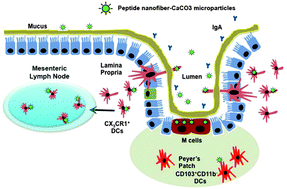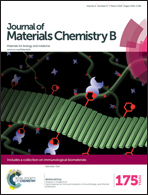Peptide nanofiber–CaCO3 composite microparticles as adjuvant-free oral vaccine delivery vehicles†
Abstract
To combat mucosal pathogens that cause gastrointestinal (GI) infections, local mucosal immunity is required which is best achieved through oral vaccination. Oral delivery of vaccines is also a safe and convenient alternative to injected vaccines due to its non-invasive nature and high compliance rate for all ages. However, the lack of effective and safe mucosal adjuvants, the selective permeability of the mucus barrier, and the harsh GI environment continue to pose a significant challenge for oral vaccine development. Microparticle-based strategies are attractive for oral vaccination due to their ability to efficiently penetrate the mucus barrier and have the added advantage of protecting the antigen in the harsh gastric environment. In this work, self-adjuvanting peptide nanofiber–CaCO3 composite microparticles were prepared and investigated for oral vaccine delivery. Compared to polymeric microparticles, inorganic CaCO3 microparticles have unique advantages due to the biocompatibility of CaCO3 as a natural mineral, mild preparation conditions, and its porous structure that is suitable for loading other materials. Particle size distribution, nanofiber loading efficiency, morphology, and degradation in simulated gastric fluid were characterized. The composite microparticles were efficient at penetrating the mucus barrier and were localized to immune inductive sites and elicited the production of mucosal antibody responses, particularly the protective IgA isotype following oral administration. The magnitude of the mucosal immune response was comparable to the gold-standard adjuvant cholera toxin B (CTB). Our results indicate that OVA-KFE8/CaCO3 composite microparticles are efficient self-adjuvanting oral vaccine delivery vehicles for induction of mucosal antibody responses.

- This article is part of the themed collection: Immunological Biomaterials

 Please wait while we load your content...
Please wait while we load your content...